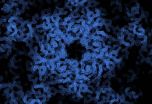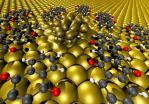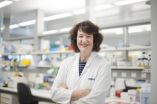(Press-News.org) RICHLAND, Wash. -- To make fuel cells more economical, engineers want a fast and efficient iron-based molecule that splits hydrogen gas to make electricity. Online Feb. 17 at Nature Chemistry, researchers report such a catalyst. It is the first iron-based catalyst that converts hydrogen directly to electricity. The result moves chemists and engineers one step closer to widely affordable fuel cells.
"A drawback with today's fuel cells is that the platinum they use is more than a thousand times more expensive than iron," said chemist R. Morris Bullock, who leads the research at the Department of Energy's Pacific Northwest National Laboratory.
His team at the Center for Molecular Electrocatalysis has been developing catalysts that use cheaper metals such as nickel and iron. The one they report here can split hydrogen as fast as two molecules per second with an efficiency approaching those of commercial catalysts. The center is one of 46 Energy Frontier Research Centers established by the DOE Office of Science across the nation in 2009 to accelerate basic research in energy.
Fuel cells generate electricity out of a chemical fuel, usually hydrogen. The bond within a hydrogen molecule stores electricity, where two electrons connect two hydrogen atoms like a barbell.
Fuel cells use a platinum catalyst -- essentially a chunk of metal -- to crack a hydrogen molecule open like an egg: The electron whites run out and form a current that is electricity. Because platinum's chemical nature gives it the ability to do this, chemists can't simply replace the expensive metal with the cheaper iron or nickel. However, a molecule that exists in nature called a hydrogenase (high-dra-jin-ace) uses iron to split hydrogen.
Bullock and his PNNL colleagues, chemists Tianbiao "Leo" Liu and Dan DuBois, have taken inspiration for their iron-wielding catalyst from a hydrogenase. First Liu created several potential molecules for the team to test. Then, with the best-working molecule up to that point, they determined and tweaked the shape and the internal electronic forces to make additional improvements.
One of the tricks they needed the catalyst to do was to split hydrogen atoms into all of their parts. If a hydrogen atom is an egg, the positively charged proton that serves as the nucleus of the atom would be the yolk. And the electron, which orbits around the proton in a cloud, would be the white. The catalyst moves both the proton-yolks and electron-whites around in a controlled series of steps, sending the protons in one direction and the electrons to an electrode, where the electricity can be used to power things.
To do this, they need to split hydrogen molecules unevenly in an early step of the process. One hydrogen molecule is made up of two protons and two electrons, but the team needed the catalyst to tug away one proton first and send it away, where it is caught by a kind of molecule called a proton acceptor. In a real fuel cell, the acceptor would be oxygen.
Once the first proton with its electron-wooing force is gone, the electrode easily plucks off the first electron. Then another proton and electron are similarly removed, with both of the electrons being shuttled off to the electrode.
The team determined the shape and size of the catalyst and also tested different proton acceptors. With the iron in the middle, arms hanging like pendants around the edges draw out the protons. The best acceptors stole these drawn-off protons away quickly.
With their design down, the team measured how fast the catalyst split molecular hydrogen. It peaked at about two molecules per second, thousands of times faster than the closest, non-electricity making iron-based competitor. In addition, they determined its overpotential, which is a measure of how efficient the catalyst is. Coming in at 160 to 220 millivolts, the catalyst revealed itself to be similar in efficiency to most commercially available catalysts.
Now the team is figuring out the slow steps so they can make them faster, as well as determining the best conditions under which this catalyst performs.
###
This work was supported by the Department of Energy, Office of Science.
Reference: Tianbiao Liu, Daniel L. DuBois and R. Morris Bullock. An iron complex with pendent amines as a molecular electrocatalyst for oxidation of hydrogen, Nature Chemistry, Month Day, 2013, doi:10.1038/NCHEM.1571.
Interdisciplinary teams at Pacific Northwest National Laboratory address many of America's most pressing issues in energy, the environment and national security through advances in basic and applied science. PNNL employs 4,500 staff, has an annual budget of nearly $1 billion, and has been managed for the U.S. Department of Energy by Ohio-based Battelle since the laboratory's inception in 1965. For more, visit the PNNL's News Center, or follow PNNL on Facebook, LinkedIn and Twitter.
DOE's Office of Science is the single largest supporter of basic research in the physical sciences in the United States, and is working to address some of the most pressing challenges of our time. For more information, please visit the Office of Science website at science.energy.gov.
Synthetic molecule first electricity-making catalyst to use iron to split hydrogen gas
Fast and efficient biologically inspired catalyst could someday make fuel cells cheaper
2013-02-18
ELSE PRESS RELEASES FROM THIS DATE:
Diamond sheds light on basic building blocks of life
2013-02-18
The UK's national synchrotron facility, Diamond Light Source, is now the first and only place in Europe where pathogens requiring Containment Level 3 – including serious viruses such as those responsible for AIDS, Hepatitis and some types of flu – can be analysed at atomic and molecular level using synchrotron light. This special light allows scientists to study virus structures at intense levels of detail and this new facility extends that capability to many viruses that have a major global impact on human and animal health. Studying pathogens in this way has the potential ...
Organic electronics -- how to make contact between carbon compounds and metal
2013-02-18
Until now, however, it was practically impossible to accurately predict which molecules performed well on the job. They basically had to be identified by trial-and-error.
Now, an international team of scientists around Dr. Georg Heimel and Prof. Norbert Koch from the HZB and the Humboldt University Berlin has unraveled the mystery of what these molecules have in common. Their discovery enables more focused improvements to contact layers between metal electrodes and active materials in organic electronic devices.
"We have been working on this question for a number of ...
'Activating' RNA takes DNA on a loop through time and space
2013-02-18
Long segments of RNA— encoded in our DNA but not translated into protein—are key to physically manipulating DNA in order to activate certain genes, say researchers at The Wistar Institute. These non-coding RNA-activators (ncRNA-a) have a crucial role in turning genes on and off during early embryonic development, researchers say, and have also been connected with diseases, including some cancers, in adults.
In an online article of the journal Nature, a team of scientists led by Wistar's Ramin Shiekhattar, Ph.D., detail the mechanism by which long non-coding RNA-activators ...
Dopants dramatically alter electronic structure of superconductor
2013-02-18
UPTON, NY - Over the last quarter century, scientists have discovered a handful of materials that can be converted from magnetic insulators or metals into "superconductors" able to carry electrical current with no energy loss-an enormously promising idea for new types of zero-resistance electronics and energy-storage and transmission systems. At present, a key step to achieving superconductivity (in addition to keeping the materials very cold) is to substitute a different kind of atom into some positions of the "parent" material's crystal framework. Until now, scientists ...
'Snooze button' on biological clocks improves cell adaptability
2013-02-18
The circadian clocks that control and influence dozens of basic biological processes have an unexpected "snooze button" that helps cells adapt to changes in their environment.
A study by Vanderbilt University researchers published online Feb. 17 by the journal Nature provides compelling new evidence that at least some species can alter the way that their biological clocks function by using different "synonyms" that exist in the genetic code.
"This provides organisms with a novel and previously unappreciated mechanism for responding to changes in their environment," said ...
Microbes team up to boost plants' stress tolerance
2013-02-18
UNIVERSITY PARK, PA. -- While most farmers consider viruses and fungi potential threats to their crops, these microbes can help wild plants adapt to extreme conditions, according to a Penn State virologist.
Discovering how microbes collaborate to improve the hardiness of plants is a key to sustainable agriculture that can help meet increasing food demands, in addition to avoiding possible conflicts over scare resources, said Marilyn Roossinck, professor of plant pathology and environmental microbiology, and biology.
"It's a security issue," Roossinck said. "The amount ...
Ancient teeth bacteria record disease evolution
2013-02-18
DNA preserved in calcified bacteria on the teeth of ancient human skeletons has shed light on the health consequences of the evolving diet and behaviour from the Stone Age to the modern day.
The ancient genetic record reveals the negative changes in oral bacteria brought about by the dietary shifts as humans became farmers, and later with the introduction of food manufacturing in the Industrial Revolution.
An international team, led by the University of Adelaide's Centre for Ancient DNA (ACAD) where the research was performed, has published the results in Nature Genetics ...
Wiring the ocean
2013-02-18
For most people, the sea is a deep, dark mystery. That is changing, though, as scientists find innovative ways to track the movements of ocean-going creatures.
Stanford marine sciences professor and Stanford Woods Institute Senior Fellow Barbara Block is using technology to enable live feeds of animal movements relayed by a series of "ocean WiFi hotspots." This could help protect marine ecosystems by revolutionizing how we understand their function, population structure, fisheries management and species' physiological and evolutionary constraints.
Block will explain ...
Excessive TV in childhood linked to long-term antisocial behaviour
2013-02-18
Children and adolescents who watch a lot of television are more likely to manifest antisocial and criminal behaviour when they become adults, according to a new University of Otago, New Zealand, study published online in the US journal Pediatrics.
The study followed a group of around 1000 children born in the New Zealand city of Dunedin in 1972-73. Every two years between the ages of 5 and 15, they were asked how much television they watched. Those who watched more television were more likely to have a criminal conviction and were also more likely to have antisocial ...
Pathway controlling cell growth revealed
2013-02-18
A Melbourne-based research team has discovered a genetic defect that can halt cell growth and force cells into a death-evading survival state.
The finding has revealed an important mechanism controlling the growth of rapidly-dividing cells that may ultimately lead to the development of new treatments for diseases including cancer.
The discovery was made by Associate Professor Joan Heath, Dr Yeliz Boglev and colleagues at the Melbourne-Parkville Branch of the Ludwig Institute for Cancer Research. Dr Kate Hannan, Associate Professor Rick Pearson and Associate Professor ...
LAST 30 PRESS RELEASES:
Scientists trace microplastics in fertilizer from fields to the beach
The Lancet Obstetrics, Gynecology, & Women’s Health: Taking paracetamol during pregnancy does not increase risk of autism, ADHD or intellectual disabilities, confirms new gold-standard evidence review
Taking paracetamol during pregnancy does not increase risk of autism, ADHD or intellectual disabilities
Harm reduction vending machines in New York State expand access to overdose treatment and drug test strips, UB studies confirm
University of Phoenix releases white paper on Credit for Prior Learning as a catalyst for internal mobility and retention
Canada losing track of salmon health as climate and industrial threats mount
Molecular sieve-confined Pt-FeOx catalysts achieve highly efficient reversible hydrogen cycle of methylcyclohexane-toluene
Investment in farm productivity tools key to reducing greenhouse gas
New review highlights electrochemical pathways to recover uranium from wastewater and seawater
Hidden pollutants in shale gas development raise environmental concerns, new review finds
Discarded cigarette butts transformed into high performance energy storage materials
Researchers highlight role of alternative RNA splicing in schizophrenia
NTU Singapore scientists find new way to disarm antibiotic-resistant bacteria and restore healing in chronic wounds
Research suggests nationwide racial bias in media reporting on gun violence
Revealing the cell’s nanocourier at work
Health impacts of nursing home staffing
Public views about opioid overdose and people with opioid use disorder
Age-related changes in sperm DNA may play a role in autism risk
Ambitious model fails to explain near-death experiences, experts say
Multifaceted effects of inward foreign direct investment on new venture creation
Exploring mutations that spontaneously switch on a key brain cell receptor
Two-step genome editing enables the creation of full-length humanized mouse models
Pusan National University researchers develop light-activated tissue adhesive patch for rapid, watertight neurosurgical sealing
Study finds so-called super agers tend to have at least two key genetic advantages
Brain stimulation device cleared for ADHD in the US is overall safe but ineffective
Scientists discover natural ‘brake’ that could stop harmful inflammation
Tougher solid electrolyte advances long-sought lithium metal batteries
Experts provide policy roadmap to reduce dementia risk
New 3D imaging system could address limitations of MRI, CT and ultrasound
First-in-human drug trial lowers high blood fats
[Press-News.org] Synthetic molecule first electricity-making catalyst to use iron to split hydrogen gasFast and efficient biologically inspired catalyst could someday make fuel cells cheaper


